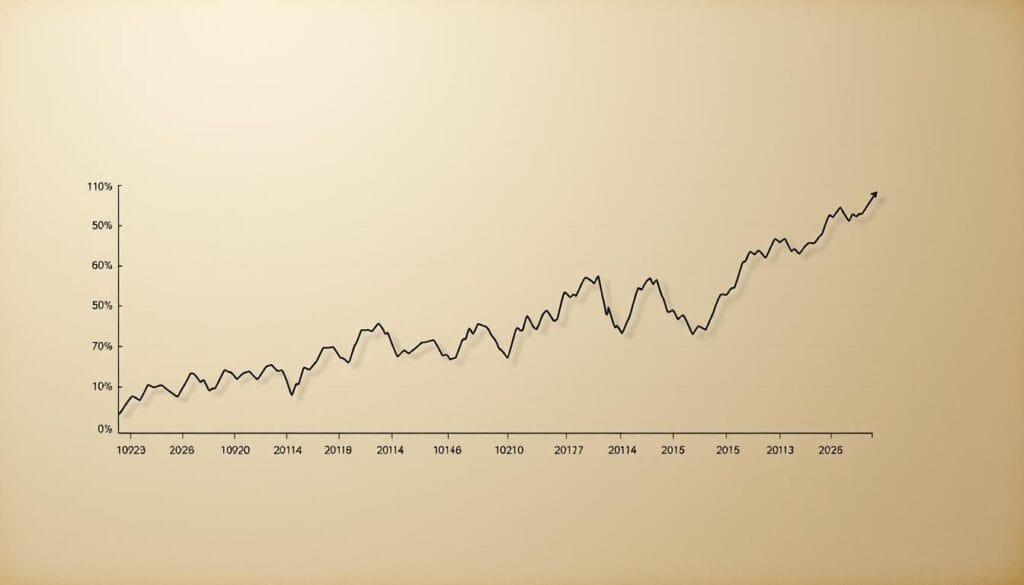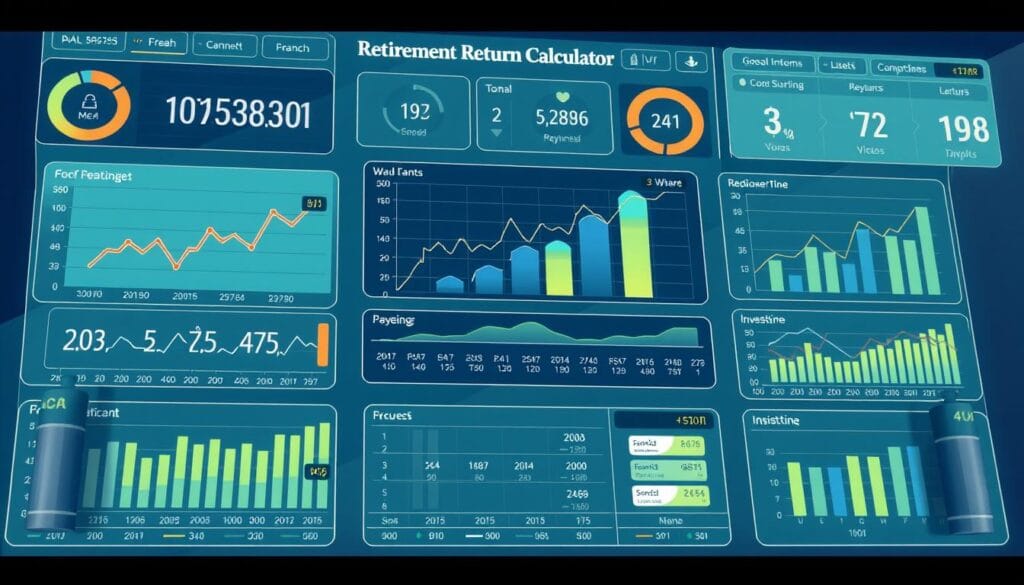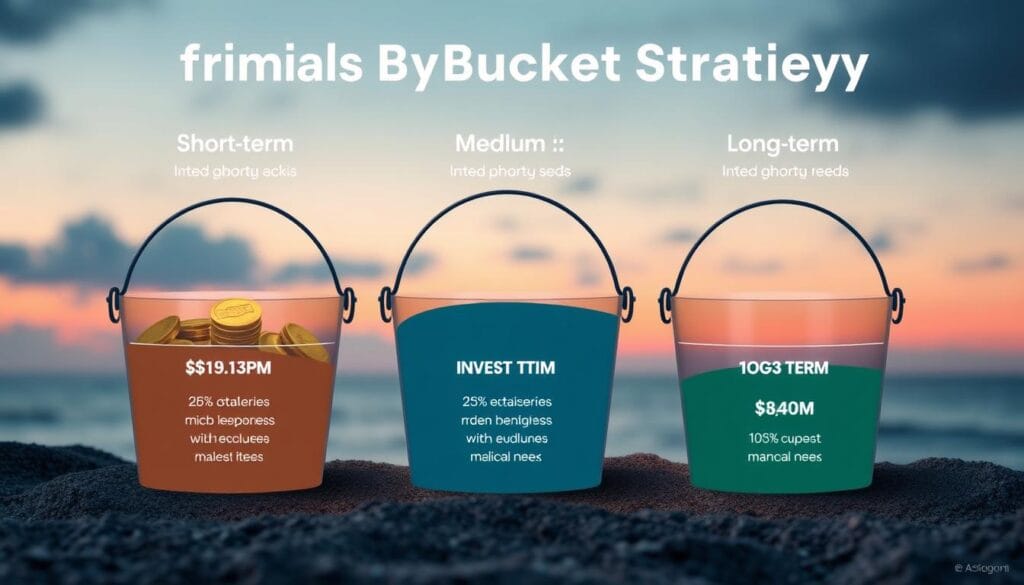A realistic rate of return is crucial for creating an accurate retirement plan. Many retirees overestimate potential returns or fail to account for factors like inflation and fees that reduce real returns.
Understanding the real rate of return helps you grasp how much income you’ll have in retirement. A comprehensive retirement strategy must balance growth potential with risk management to ensure your portfolio sustains your lifestyle throughout retirement.
Key Takeaways
- Accurate retirement planning requires understanding investment returns.
- Market cycles and inflation impact returns.
- A realistic rate of return is essential for a sustainable income stream.
- Risk management is crucial for a retirement portfolio.
- Retirement planning involves analyzing historical data and applying realistic expectations.
Understanding Real vs. Nominal Returns in Retirement Planning

When planning for retirement, understanding the difference between real and nominal returns is crucial for setting realistic income expectations. Nominal returns represent the raw percentage gain on investments before accounting for any external factors. In contrast, real returns reflect what you actually keep after accounting for inflation, taxes, and investment fees.
The Difference Between Nominal and Real Returns
Nominal returns are the straightforward gains from investments without considering external factors like inflation. For instance, if you invest in a fund with an 8% nominal rate of return, it might seem like a good investment. However, inflation, fees, and taxes can significantly erode these gains. Real returns, on the other hand, provide a more accurate picture by accounting for these factors. As noted by financial experts, understanding this difference is key to avoiding the shock of diminished purchasing power in retirement.
“The biggest mistake investors make is not understanding the impact of inflation on their returns,” says a financial analyst. “It’s not just about the nominal return; it’s about what you’re left with after inflation and fees.”
How Fees, Taxes, and Inflation Impact Your Returns
Let’s consider an example where you invest $100,000 in a fund with an 8% nominal rate of return. With a 0.5% management fee and 3% inflation, your real return before taxes would be 4.5%. If your retirement account isn’t a Roth account, you’ll also need to pay income taxes on withdrawals, further reducing your net returns. For instance, if you’re in a 24% tax bracket, your real return could be reduced even further. To maximize your retirement income, it’s essential to consider these factors and potentially explore tax-efficient strategies, such as those discussed in our article on planning your retirement with AI-powered financial.
- Inflation alone has historically averaged around 3% annually, meaning a 7% nominal return translates to only a 4% real return before other deductions.
- Investment fees, including management fees and transaction costs, can subtract 0.5-2% from returns depending on your investment vehicles.
- Tax implications vary based on account types and income brackets, with some retirement accounts offering tax-deferred growth but taxable withdrawals.
Historical Investment Returns: What the Past Tells Us

The past performance of various investments offers a roadmap for retirement income planning. By examining historical returns, investors can better understand the potential risks and rewards associated with different asset classes.
Stock Market Performance Over Time
The stock market has historically provided significant returns over the long term. For instance, the S&P 500 has delivered an average annual return of about 10% over the last 50 years. Adjusted for an average inflation rate of 3%, this translates to a real return of 7% before administration fees and taxes. It’s essential to note that while the stock market has shown resilience and growth, there is considerable year-to-year volatility.
Bond Market Returns
The bond market has traditionally offered more modest but stable returns compared to stocks. Long-term government bonds have averaged around 5% annually, while corporate bonds have yielded slightly higher returns, typically between 6-7%. These returns are attractive for investors seeking predictable income, particularly in retirement portfolios.
Alternative Investment Returns
Alternative investments, such as Real Estate Investment Trusts (REITs), have delivered competitive returns. For example, REITs averaged a 12.2% return over the 10-year period from 2012 to 2021, outperforming many traditional investments. Real estate investments, including single-family homes, generated around 7.8% annual returns over the same period, offering both income and appreciation potential. Commodities like gold and oil have also served as inflation hedges, with 20-year returns of 7.75% and 7%, respectively, from 1999 to 2018.
For more information on creating a robust retirement plan, visit Best Retirement Income Strategies for 2025. Historical data reveals that different asset classes perform differently across various economic cycles, highlighting the importance of diversification in retirement portfolios. By understanding past performance patterns, investors can make more informed decisions, although it’s crucial to remember that past results do not guarantee future performance.
Key Factors Affecting Your Retirement Investment Returns

Understanding the factors that affect your retirement investment returns is essential for a secure retirement. Your rate of return is subject to various factors beyond taxes, fees, and inflation, varying due to individual circumstances and preferences.
Risk Tolerance and Age Considerations
As you approach retirement, your risk tolerance naturally decreases, requiring a gradual shift from growth-focused investments to more conservative allocations to protect accumulated wealth. Age-based considerations typically follow the “100 minus your age” rule for stock allocation, though modern longevity may justify more aggressive approaches for some investors.
Asset Allocation Strategies
Asset allocation strategies must balance growth needs against volatility protection. Traditional retirement portfolios often follow 60/40 or 50/50 stock/bond splits. For example, you can consider mutual funds that align with your retirement goals and risk tolerance.
Market Timing and Retirement Date
The timing of your retirement relative to market cycles can dramatically impact long-term returns. Retiring during a market downturn forces liquidation of assets at depressed values. Retirement date flexibility can serve as a risk management tool, allowing investors to delay retirement during market downturns rather than depleting portfolios at inopportune times.
Personal factors, including health expectations, family longevity, and lifestyle preferences, should influence your investment approach and risk tolerance assessment. The transition from accumulation to distribution phase requires fundamental shifts in investment strategy that many pre-retirees overlook until too late.
- Risk tolerance decreases as retirement approaches.
- Age-based considerations guide stock allocation.
- Asset allocation balances growth and volatility.
- Market timing affects long-term returns.
- Retirement date flexibility manages risk.
Predicting Investment Returns for Retirement: Realistic Approaches

To ensure a secure retirement, it’s essential to adopt realistic strategies for predicting investment returns. Predicting investment returns for retirement involves understanding various factors that can impact your retirement savings.
Using Historical Data Effectively
Historical data provides valuable context for retirement planning, but it must be used carefully. Investors should consider both long-term averages and the range of potential outcomes rather than focusing on favorable periods. By analyzing historical trends, investors can make more informed decisions about their retirement investments.
Monte Carlo Simulations Explained
Monte Carlo simulations have become the gold standard for retirement planning. These simulations run thousands of scenarios with randomized returns to determine the probability of retirement success. Unlike static models, Monte Carlo analysis incorporates market volatility and sequence risk, providing a more realistic picture of potential outcomes. For instance, a Monte Carlo simulation might show that a retirement plan has an 80% chance of success, meaning that in 20% of scenarios, the portfolio would be depleted before the end of retirement.
The Importance of Adjusting Predictions Over Time
Regular reassessment of retirement projections is essential as market conditions, personal circumstances, and financial goals evolve over time. Investors should adjust their predictions and strategies accordingly to ensure they remain on track to meet their retirement objectives. Utilizing tools like a retirement investment return calculator can help in making these adjustments.
By adopting a comprehensive approach to predicting investment returns, investors can better prepare for retirement. This involves not only using historical data and Monte Carlo simulations but also regularly reviewing and adjusting their retirement plans.
The Sequence of Returns Risk in Retirement Planning
When planning for retirement, understanding the impact of the sequence of returns risk is crucial. This risk refers to the potential for negative investment returns in the early years of retirement, which can significantly impact the sustainability of your retirement income.
The sequence of returns risk represents one of the greatest threats to retirement security. Unlike during the accumulation phase, where dollar-cost averaging can mitigate the impact of market timing, the withdrawal phase makes timing critical because retirees must sell assets to generate income. Studies have shown that two identical portfolios with the same average returns but different sequences of returns can have dramatically different outcomes – one lasting 40+ years while another depletes in just 25 years.
Understanding How Timing Affects Your Retirement
The first 5-10 years of retirement are particularly crucial. Portfolio losses during this period, combined with withdrawals, create a compounding negative effect that’s difficult to recover from. For example, an investor who retires during a market downturn may see their portfolio lose significant value, making it challenging to sustain their retirement plan over time.
Strategies to Mitigate Sequence Risk
To mitigate sequence risk, consider the following strategies:
- Building a cash buffer to cover 2-3 years of expenses.
- Implementing a dynamic withdrawal strategy that adjusts spending based on market performance.
- Creating dedicated income streams through annuities or bond ladders.
- Maintaining some growth-oriented investments even in retirement to combat inflation and extend portfolio longevity.
For more information on optimizing your retirement plans, you may want to explore resources like top Roth IRA providers for 2025, which can help you make informed decisions about your retirement savings.
Creating a Retirement Bucket Strategy

Creating a retirement bucket strategy is essential for a secure financial future. This approach involves dividing your retirement assets into three distinct buckets to meet different needs at various stages of your retirement.
Immediate Needs Bucket
The immediate needs bucket is designed to cover your day-to-day expenses for the first three to five years of retirement. It’s crucial to keep this money in liquid, low-risk investments such as cash, money market accounts, CDs, and short-term bonds. This bucket helps you avoid selling assets during market downturns, thereby protecting your portfolio.
Short-Term Goals Bucket
The short-term goals bucket is invested more aggressively to meet your needs between years three to ten of retirement. A disciplined asset allocation strategy is recommended to balance growth potential with stability. Regularly shifting some of the money from this bucket to the immediate needs bucket helps maintain liquidity.
Long-Term Growth Bucket
The long-term growth bucket is for assets you won’t need for 10+ years, allowing for more aggressive investments to maximize growth and combat inflation. This bucket can also be used for legacy planning, potentially incorporating alternative investments beyond traditional stocks and bonds. For more information on managing your retirement payout, you can visit Annuity vs. Lump Sum: Choosing Your Retirement Payout in.
By implementing a retirement bucket strategy, you can create a comprehensive income plan that addresses your needs throughout retirement. This approach helps in managing sequence of returns risk and ensures that your portfolio remains resilient over time.
Maximizing Your Real Rate of Return in Retirement
Maximizing your real rate of return is vital for maintaining a healthy cash flow during retirement. As retirees face the challenges of inflation, taxes, and market volatility, a well-crafted investment strategy can help ensure a stable financial future.
Combating Inflation in Your Retirement Portfolio
Inflation can significantly erode the purchasing power of your retirement savings. To combat this, consider investing in assets that historically perform well during inflationary periods. Value stocks are an excellent option as they tend to rise with inflation. Additionally, Treasury Inflation-Protected Securities (TIPS) can provide a low-risk investment that adjusts its par value with inflation. For example, a $1,000 TIPS with a 0.5% interest rate will increase in value if inflation rises.
Tax-Efficient Investment Strategies
Tax efficiency is crucial in retirement when every dollar counts. Strategic withdrawal sequencing from taxable, tax-deferred, and tax-free accounts can significantly reduce your lifetime tax burden. Consider placing tax-inefficient investments in tax-advantaged accounts to minimize drag on your returns. This approach can help you retain more of your hard-earned savings.
Portfolio Diversification Techniques
Diversification is key to managing risk and enhancing returns. Beyond traditional stock and bond allocations, consider including alternative asset classes such as REITs, commodities, and international securities. Regularly rebalancing your portfolio, typically annually or when allocations drift by 5% or more, can help maintain your risk profile while potentially enhancing returns through systematic buying low and selling high.
- Inflation represents a significant threat to retirement security, eroding purchasing power by 2-3% annually on average.
- Incorporating inflation-fighting assets like TIPS, value stocks, and real estate can help maintain purchasing power.
- Tax efficiency becomes increasingly important in retirement, and strategic withdrawal sequencing can reduce your lifetime tax burden.
- Portfolio diversification should extend beyond traditional stock/bond allocation to include alternative asset classes.
By implementing these strategies, retirees can maximize their real rate of return and ensure a more secure financial future. Working with a financial advisor who specializes in retirement income planning can also help identify opportunities to enhance returns while managing risk.
Conclusion: Building a Resilient Retirement Plan
Effective retirement planning demands a thorough grasp of investment returns, including the impact of inflation and market volatility. A realistic understanding of these factors is crucial for creating a sustainable income stream throughout your retirement.
To achieve this, it’s essential to account for various elements that affect your retirement income, such as taxes, fees, and inflation. By adopting strategies like diversifying your portfolio and investing in inflation-linked bonds, you can better navigate the complexities of retirement planning.
Working with a qualified financial advisor can provide valuable expertise in managing investment risk and creating a tailored retirement plan. For those looking to optimize their investment strategy, exploring options like robo-advisors can be beneficial. You can start by checking out top robo-advisors for beginners to find a suitable platform.
Ultimately, the goal is to create a resilient retirement plan that combines multiple income streams, including Social Security, pensions, and systematic portfolio withdrawals, to ensure a stable financial future. Regular reassessment of your plan will help you adapt to changing market conditions and personal circumstances, securing your retirement income for years to come.

